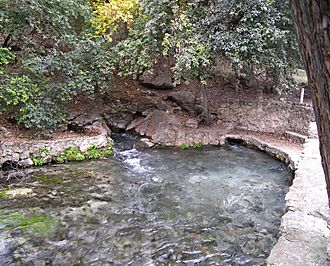Comal Springs (Texas) facts for kids
Quick facts for kids Comal Springs |
|
|---|---|

The largest of the Comal Springs form the headwaters of the Comal River.
|
|
| Location | New Braunfels, Texas, US |
| Coordinates | 29°42′59″N 98°08′01″W / 29.7164°N 98.1336°W |
| Spring source | Edwards Aquifer |
| Elevation | 620 feet (190 m) above sea level |
| Type | Karst spring |
| Provides water for | Comal River |
| Magnitude | 1 |
| Discharge | 318 cubic feet (9,000 L)/s |
The Comal Springs (pronounced KOH-mal) are the biggest group of natural freshwater springs in Texas. You can find them in the city of New Braunfels. These springs are formed when water slowly moves through a huge underground rock layer called the Edwards Aquifer.
Discovering Comal Springs: A Look Back in Time
For a very long time, the Comal Springs have been an important place. Native American groups, like the Tonkawa people, often gathered here. The fresh water and natural beauty made it a perfect spot.
The first European explorer to see the springs was Damián Massanet in 1691. He was from Spain. Later, a Spanish mission was built near the springs. Spanish settlers eventually gave the area the name "Las Fontanas," which means "The Fountains." Over the years, the area around the springs has been used for fun activities and businesses, including a popular park called Landa Park.
How Comal Springs Work: The Edwards Aquifer Connection
The Comal Springs get all their water from the Edwards Aquifer. An aquifer is like a giant underground sponge made of rock that holds water. The Edwards Aquifer is a special type called a karst aquifer. This means it has many holes and cracks in its limestone rock.
When it rains, water soaks into the ground in certain areas. This water then travels through the cracks and tunnels in the limestone. It flows deep underground until it reaches places where it can come back to the surface, like the Comal Springs. This is how the springs are constantly refilled with fresh water.
Amazing Animals and Plants of Comal Springs
The Comal Springs are home to many unique plants and animals. Some of these species can only be found in this special place. It's like their own private natural habitat!
One very important animal that lives here is the fountain darter. This small fish (Etheostoma fonticola) needs the clean, flowing water of the springs to survive. The area around the springs is also a natural dividing line for some plants. For example, the California Fan Palm (Washingtonia filifera) grows only west of the Comal Springs. This shows how important the springs are to the local ecosystem.

